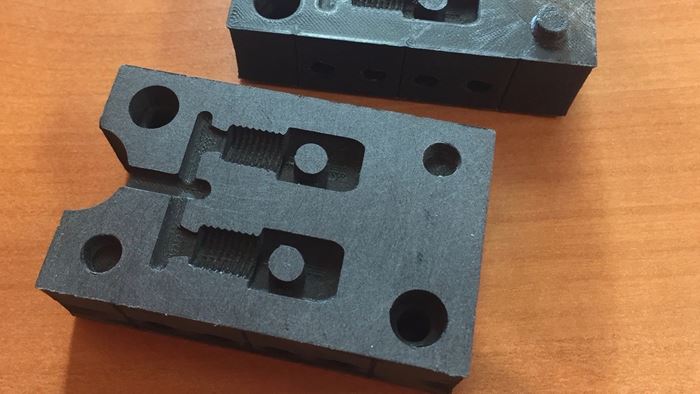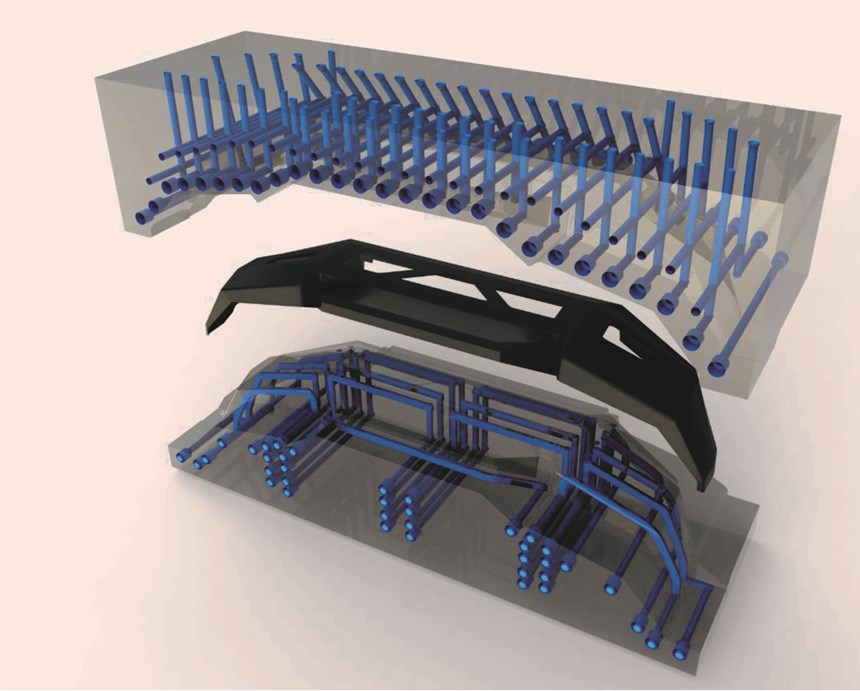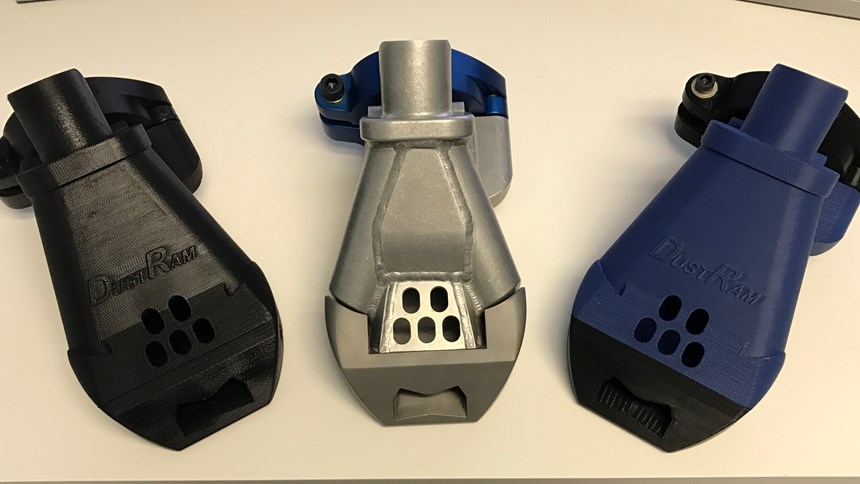10 Ways 3D Printing Is Advancing Plastics Manufacturing
By expanding possibilities for plastic parts, short-run molds and production mold tooling, additive manufacturing is becoming an important complement to established plastics processes.
Additive manufacturing is no competitor to current plastics manufacturing processes in the applications where those processes succeed best. For a production run of hundreds of thousands of parts, the option to 3D print plastic components can’t come close to competing with the speed and efficiency of a process such as injection molding. However, 3D printing as a complement to current processes is becoming more and more valuable. In many applications and in many different uses, 3D printing is both improving plastics manufacturing and expanding the options for plastic parts.
Here are just 10 of the ways we’ve seen 3D printing advancing as it relates to plastic part production:
1. Faster throughput
At certain scales, 3D printing is indeed an option for production, and the scale is increasing. Some 3D printers engineered for production today generate parts at rates an order of magnitude faster than what has previously been accepted. 3D Systems, for example, says its Figure 4 production 3D printing system increases speed by a factor of 15 over previous industrial 3D printers, reducing the unit cost of a 3D-printed part by 20 percent thanks in part to the cycle time reduction.
2. Bigger parts
A very large polymer 3D printer such as the Cincinnati Inc. BAAM machine might offer a build volume of 180 cubic meters. This is huge, and machine models such as this capture a lot of attention. But just as notable is the range of machine models now available at sizes that are much smaller, yet still large. Various machine builders have introduced cost-effective industrial 3D printers making parts the size of a large molded component. As a representative example, the 3DMonstr Super-Rex 3D printer offers a build volume of 3 cubic meters.
3. New options for short-term molds
3D printing provides a short-lead-time option for directly making a few parts, but it also provides a short-lead-time option for making an injection mold. The right choice of polymer can reliably produce mold tooling for low to medium quantities. Wyoming-based Avante Technology 3D prints injection molds from carbon fiber reinforced polymer that have consistently lasted beyond 100 cycles, and the company says could last to 500 cycles.
4. More efficient production molds
Meanwhile, 3D printing in steel can make improved mold tooling for high-volume production. With printed-in conformal cooling channels replacing straight drilled holes, the mold’s cooling is more effective, likely improving molded part quality and reducing cycle time. Mold supplier Conformal Cooling Solutions uses robotic deposition technology to 3D print large injection molds with conformal channels.
5. Customization for consumer products
Medical and dental products are now routinely tailored to the individual via 3D printing, so how far are we from consumer products following suit? The work of various footwear providers suggests shoes will soon be widely available that optimally fit the wearer’s feet. Footprint 3D is an example of a company advancing this idea; the firm uses 3D scans of an individual’s feet to 3D print shoes with custom midsoles featuring lattices for precise support and cushioning.
6. New manufacturing business models
Can a manufacturing plant locate in the heart of a city? Manufacturers today tend to locate in suburban industrial parks with easy access to major highways. But because of its reliance on 3D printing, Voodoo Manufacturing is able to locate in Brooklyn. The company uses 160 desktop printers working simultaneously to achieve a part production rate that makes the company cost-competitive with injection molding—and faster in delivery—for quantities up to 10,000 pieces.
7. Plastic replacing metal
In many cases, metal is the material of choice for a given part only because it offers the easiest way to get a rugged functional component in a low quantity. Machining the part from aluminum is a practical option. But with 3D printing now able to efficiently deliver polymer parts in low quantities, metal will not be the material of choice so frequently. Carbon-fiber-filled 3D-printed polymer can serve as the material for components previously expected to be metal.
8. More efficient toolmaking
3D printing thrives on one-off parts, and perhaps the most common type of one-off part in any manufacturing facility is its own internal tooling. That is, not just mold tooling but jigs, fixtures and all manner of industrial tools. Much of this tooling can be made from polymer instead of metal components, and when it is made on a 3D printer, it need not consume production capacity or even take up much of the production personnel’s time. With 3D printing, Volkswagen Autoeuropa reduced its tool development time by 95 percent while improving tools’ ergonomics and simplifying tool repair and modification.
9. Prototyping without impeding production
And just as making tooling need not cut into production, making prototypes can be kept isolated from production resources as well. Desktop polymer printers often can be effective not just for look-and-feel prototypes but for functional prototypes as well. Stanley Black & Decker recently introduced a simple 3D desktop printer with a 200-mm-square build area. With a resource such as this, the engineer might be able to make a prototype at his or her desk without enlisting the attention of manufacturing staff.
10. Manufacturing moving in-house
As companies adopt industrial 3D printers to accelerate product development by prototyping in-house, it becomes only a short leap to manufacturing production parts in-house as well. Arizona Home Floors, a developer of tools for installing and removing flooring, never intended to become a manufacturer. It had previously outsourced manufacturing. But for a new chipping hammer it recently developed, manufacturing parts on the same 3D printer that had prototyped the parts proved to be the most efficient approach. As more companies choose this route, 3D printing is expanding not only the application of plastics, but also who is doing plastics manufacturing.
Related Content
What Does Additive Manufacturing Readiness Look Like?
The promise of distributed manufacturing is alluring, but to get there AM first needs to master scale production. GKN Additive’s Michigan facility illustrates what the journey might look like.
Read MoreAdditive Manufacturing Is Subtractive, Too: How CNC Machining Integrates With AM (Includes Video)
For Keselowski Advanced Manufacturing, succeeding with laser powder bed fusion as a production process means developing a machine shop that is responsive to, and moves at the pacing of, metal 3D printing.
Read MoreVulcanForms Is Forging a New Model for Large-Scale Production (and It's More Than 3D Printing)
The MIT spinout leverages proprietary high-power laser powder bed fusion alongside machining in the context of digitized, cost-effective and “maniacally focused” production.
Read MoreUnderstanding HP's Metal Jet: Beyond Part Geometry, Now It's About Modularity, Automation and Scale
Since introducing its metal binder jetting platform at IMTS in 2018, HP has made significant strides to commercialize the technology as a serial production solution. We got an early preview of the just-announced Metal Jet S100.
Read MoreRead Next
Video: Intelligent Layering Metal 3D Printing at 3DEO
Contract manufacturer 3DEO delivers metal parts using Intelligent Layering, a binder jetting-like 3D printing process the company developed and operates internally. Here’s how it works.
Read MoreTo Improve Performance of Compression Molded Composites, Add 3D Printed Preforms
9T Labs' Additive Fusion Technology enables the manufacture of composite structures with as much or as little reinforcement as is necessary, using 3D printed continuous fiber preforms to add strength just where needed.
Read MoreGE Additive Rebrands as Colibrium Additive
As part of the brand name transition, both the Concept Laser and Arcam EBM legacy brands will be retired.
Read More














.png;maxWidth=300;quality=90)












